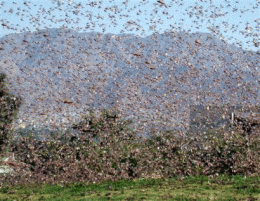January 23, 2009 feature
Scientists use Brownian Motion to Explore How Birds Flock Together

(PhysOrg.com) -- How do thousands of fish swim together in giant schools, seemingly moving as a single body? Flocks of birds, herds of beasts, and a variety of other animals in nature seem to share this same “property” of coming together and moving in unison.
The phenomenon, called collective motion, is common in nature, exhibited by groups that fly, run, and swim, such as swarms of insects and colonies of bacteria. In collective motion, groups move together to form patterns as an organized (but not necessarily cooperative) single body. Scientists aren’t sure exactly what mechanisms cause the emergence of collective motion. However, the natural phenomenon has attracted the interest of researchers in diverse fields such as physics and computer science.
In a recent study, researchers have modeled collective motion using Brownian particles, and they observed as individual particles interact via escape and pursuit movements. Motivated by a previous study that observed cannibalistic interactions in locust and cricket swarms, the scientists found that both escape and pursuit movements can cause collective motion, but escape movements dominated the particular case of insect swarming. Pawel Romanczuk and Lutz Schimansky-Geier of Humboldt University Berlin, and Iain D. Couzin of Princeton University, have published their study in a recent issue of Physical Review Letters.
“Our work can be considered as a link between the simplest models of collective motion with a general (not further specified) velocity alignment interaction and more complicated models from biology based on behavioral rules,” Romanczuk told PhysOrg.com. “By assuming that the escape and pursuit are the actual behavioral responses of individuals underlying collective motion in nature, it is possible to determine which one of these responses dominates the individual behavior by simply looking at the global migration patterns.”
In their study, the researchers modeled an individual as a Brownian particle that possesses internal energy so that it can move at various speeds in reaction to external stimuli. In Brownian motion, a solitary individual explores its environment by a continuous random walk. If approached from behind by another individual, the individual in question escapes by increasing its velocity in the forward direction to prevent getting attacked from behind. If the individual senses another individual in front moving away, it pursues that individual, increasing its velocity toward the escapee. In short, an individual has two movements: escape and pursuit.
The scientists found that, at sufficiently high particle densities, the escape and pursuit interactions can both lead to global collective motion. Interestingly, each interaction by itself has a different effect on the particle distribution. In general, escape interactions homogenize and spread out the particle distribution, while pursuit interactions facilitate the formation of clusters. Overall, the combined escape and pursuit interactions seem to consist of a competition between two opposing effects, in which the outcome is determined by the relative interaction strengths.
The researchers suggest that the Brownian model can help explain the mechanisms behind a wide range of swarming phenomena in nature, from marching insects to schools of fish. Different kinds of swarm formations are likely dominated by either escape or pursuit interactions, depending on how aggressive or non-aggressive the individuals are, respectively. For instance, marching insect formations seem to be dominated by escape behavior, while fish school formations seem to be dominated by pursuit interactions.
“The understanding of collective motion has a clear application in evolutionary biology,” Romanczuk said. “As all animal behavior was subject to evolution, a behavior leading to formation of swarms might have given the corresponding individuals an evolutionary advantage: protection from predators, increased foraging success or, as in our case, prevention from being cannibalized by others. The understanding and the study of collective motion might help to identify the involved evolutionary pressures. Furthermore, the understanding of the onset of collective motion in locust swarms may help us to understand the formation of locusts plagues which affect millions of people and in the last consequence help to predict, or even to control, these events.”
Romanczuk added that understanding collective motion could have applications beyond biology. “The understanding of collective motion is of particular interest to engineers and computer scientists working on the design of autonomous robots. The idea is that simple communicating agents may perform complex tasks as a group without the permanent control of a human for each individual, and which are also robust against the failure of individual agents within the group. Examples of such applications are coordinated automated investigation of environments, which are dangerous and/or difficult to access.
“Finally, mathematical models describing collective motion of animals find applications in computer science and in the production of realistic computer animations of large animal swarms or even human crowds, which are also used in movie productions.”
More information: Romanczuk, Pawel; Couzin, Iain D.; and Schimansky-Geier, Lutz. “Collective Motion due to Individual Escape and Pursuit Response.” Physical Review Letters 102, 010602 (2009).
Copyright 2008 PhysOrg.com.
All rights reserved. This material may not be published, broadcast, rewritten or redistributed in whole or part without the express written permission of PhysOrg.com.





















